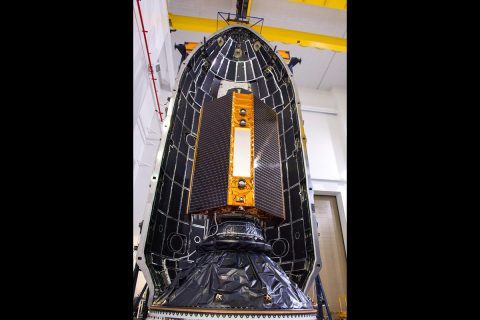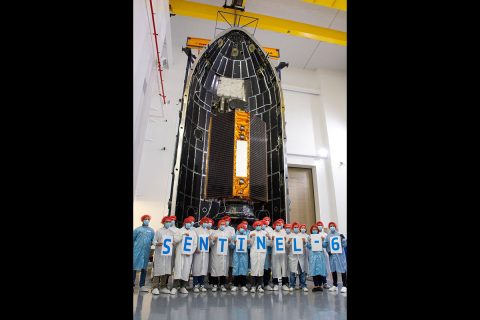 Pasadena, CA – NASA says with a little over two weeks to go until its California launch, the Sentinel-6 Michael Freilich spacecraft is undergoing final preparations. Technicians and engineers have encapsulated the satellite in the payload fairing – the protective nosecone that will ride atop the SpaceX Falcon 9 rocket. The launch is targeted for November 21st, 2020.
Pasadena, CA – NASA says with a little over two weeks to go until its California launch, the Sentinel-6 Michael Freilich spacecraft is undergoing final preparations. Technicians and engineers have encapsulated the satellite in the payload fairing – the protective nosecone that will ride atop the SpaceX Falcon 9 rocket. The launch is targeted for November 21st, 2020.
“We’re almost there,” said project manager Parag Vaze of NASA’s Jet Propulsion Laboratory in Southern California.

About the size of a small pickup truck, Sentinel-6 Michael Freilich will play a central role in efforts to track sea level rise caused by climate change. What’s more, the data that it collects on sea level variations near coastlines will provide information to support coastal management and with planning for floods, while its atmospheric measurements will enhance weather and hurricane forecasts.
Sentinel-6 Michael Freilich is one of two identical satellites that are a part of the Sentinel-6/Jason-CS (Continuity of Service) mission, a U.S.-European collaboration.

The mission is part of Copernicus, the European Union’s Earth observation program managed by the European Commission. Continuing the legacy of the Jason series missions, Sentinel-6/Jason-CS will extend the records of sea level into their fourth decade, collecting accurate measurements of sea surface height for more than 90% of the world’s oceans, and providing crucial information for operational oceanography, marine meteorology, and climate studies. Sentinel-6 Michael Freilich’s twin, Sentinel-6B, is scheduled to launch in 2025.
About the Sentinel-6 Michael Freilich Spacecraft Mission
Sentinel-6/Jason-CS is being jointly developed by ESA, the European Organisation for the Exploitation of Meteorological Satellites, NASA, and the National Oceanic and Atmospheric Administration, with funding support from the European Commission and technical support from France’s National Centre for Space Studies.
JPL, a division of Caltech in Pasadena, is contributing three science instruments for each Sentinel-6 satellite: the Advanced Microwave Radiometer, the Global Navigation Satellite System – Radio Occultation, and the Laser Retroreflector Array. NASA is also contributing launch services, ground systems supporting operation of the NASA science instruments, the science data processors for two of these instruments, and support for the U.S. members of the international Ocean Surface Topography Science Team.
The Sentinel-6 Michael Freilich press kit:
https://www.jpl.nasa.gov/news/press_kits/sentinel-6/
To learn more about Sentinel-6 Michael Freilich, visit:
https://www.nasa.gov/sentinel-6



